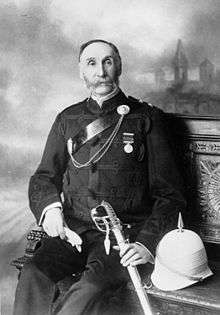William Parry-Okeden

William Edward Parry-Okeden (13 May 1841 – 30 August 1926) was a public servant, Police Commissioner and Protector of Aborigines (1895-1903), as well as a horseman, in Queensland, Australia.
Early life
William Edward Parry-Okeden was born on 13 May 1841, the son of David Parry-Okeden. He was born at Maranumbela, his father's station, Snowy River, in the Monaro District of New South Wales. Having served three years as an articled clerk to a solicitor in Melbourne, he relinquished the law and joined his father in squatting pursuits in Queensland in 1861.
Public service career
Nine years later he was appointed to initiate the Border Customs, and entered the Civil Service as Inspector of the Border Patrol in December 1870.[1] Having been employed as a police magistrate from 1872 to 1886, Parry-Okeden acted for the next three years as Immigration Agent at Brisbane, receiving the appointment of Under-Colonial Secretary in July 1889. In 1887 he acted with Kinnaird Rose on an inquiry into gaol management in Queensland.[1] He served as Queensland Police Commissioner from 1895 to 1 April 1905, when he retired from the public service.[2]
Other interests
In 1868, Parry-Okden's horse Hermit won the first Queensland Derby run at Gayndah Racecourse.[3]
Later life
Parry-Okeden died on 30 August 1926 in Brisbane and was buried in Balmoral Cemetery.[4]
External links
- 1 2 Mennell, Philip (1892). "
 Okeden, William Edward Parry". The Dictionary of Australasian Biography. London: Hutchinson & Co. Wikisource
Okeden, William Edward Parry". The Dictionary of Australasian Biography. London: Hutchinson & Co. Wikisource - ↑ Persse, Michael D. De B. Collins. Parry-Okeden, William Edward (1840–1926). Canberra: National Centre of Biography, Australian National University.
- ↑ "First Queensland Derby". Monument Australia. Retrieved 22 August 2016.
- ↑ "PIONEER PASSES.". The Brisbane Courier. National Library of Australia. 31 August 1926. p. 4. Retrieved 12 August 2013.
- Michael D. de B. Collins Persse, 'Parry-Okeden, William Edward (1840–1926)', Australian Dictionary of Biography, Volume 11, Melbourne University Press, 1988, pp 147–148.
- Friends of Balmoral Cemetery, "Balmoral Characters – William Parry-Okeden" accessed 2006-11-15